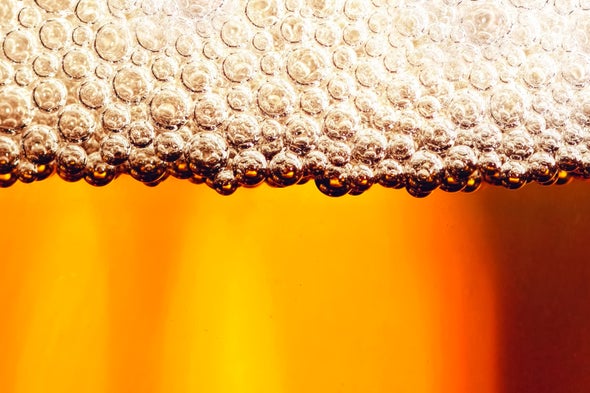(单词翻译:单击)
听力文本
This is Scientific American's 60-second Science, I'm Susanne Bard.
Some 5,600 years ago, people in the Egyptian city of Hierakonpolis did something that's still a very popular activity today: they brewed and drank beer. We know this because archaeologists examining the area near the ruins of a cemetery for the elite discovered a structure containing five ceramic vats that would have been heated from below. Residues in the vats confirmed that they had once made beer.
"And it's estimated that if these five vats were operating at the same time, 325 liters would have been produced, which is equal to 650 cans of Budweiser."
Texas Tech University microbiologist Moamen Elmassry. He says this ancient beer would have tasted very different from what our modern palates are used to. The Egyptian beer makers did use malted wheat and barley in the brewing process. But no one had mastered carbonation yet. So the resulting brew was a flat, unfiltered malt beverage with a low alcohol content.
Elmassry's colleagues recently sampled thick, dark deposits from the Hierakonpolis vats. The chemical analysis confirmed that they were indeed the product of beer making and not some other fermented food. The tests also revealed other ingredients ancient Egyptians put in their beer. The researchers found a high concentration of the amino acid proline, which is abundant in dates and some other fruits.
"This result suggests that dates could have been used or incorporated in the beer for flavor."
And maybe to add some sweet notes.

Hops—which act as both a flavoring and a preservative—weren't added to beer until medieval times.
"The use of hops was unknown to the ancient Egyptians, and we think that they used phosphoric acid to preserve their beer."
The residues were indeed high in phosphoric acid, a product of barley grains added during the fermentation process. Phosphoric acid is often used today to prolong the shelf life of alcoholic beverages.
Phosphoric acid via barley would have made it possible to mass-produce beer, store it for extended periods and even transport it—all consistent with the important role beer played in ancient Egyptian society. It not only provided hydration and nutrition but was also part of religious rituals among the elite.
The study is in the journal Scientific Reports.
Studying ancient beer has allowed Elmassry to reflect on the intersection of science and history.
"I teach a microbiology lab, and we brew beer in the lab, and the students see the whole fermentation process. And thinking about how ancient Egyptians were able to do a similar thing thousands of years ago, it's kind of very special feeling."
Thanks for listening for Scientific American's 60-second Science. I'm Susanne Bard.
参考译文
这里是科学美国人——60秒科学系列,我是苏珊娜·巴德。
大约5600年前,埃及城市希拉孔波利斯的人们进行了至今仍然很受欢迎的活动:酿造和饮用啤酒。我们之所以知道这一点,是因为考古学家在考察精英墓园遗址附近区域时,发现了一个包含五个陶瓷桶的结构,这些陶桶底部可能受过热。大桶里的残留物证实它们曾被用来酿造啤酒。
“据估计,如果这五个大桶同时工作,可生产325升啤酒,相当于650罐百威啤酒。”
得克萨斯理工大学的微生物学家莫阿门·埃尔马斯利说到。他说,这种古老的啤酒尝起来和我们现代人习惯的口味很不一样。埃及啤酒制造商在酿造过程中确实使用了小麦麦芽和大麦麦芽。但当时还没有人掌握碳酸化作用。因此,酿造出来的啤酒是一种无汽、未过滤且酒精含量很低的麦芽饮料。
埃尔马斯利的同事最近从希拉孔波利斯大桶中取样了黑稠沉积物。化学分析证实这些沉积物确实是啤酒酿造的产物,而非其他发酵食物。测试还发现了古埃及人在啤酒中加入的其他成分。研究人员发现了高浓度的脯氨酸,这种氨基酸在枣和其他水果中含量丰富。
“这一结果表明,枣可能已经被使用或加入啤酒中进行调味。”
或许是为了增加甜味。
啤酒花作为调味品和防腐剂,直到中世纪才添加到啤酒中。
“古埃及人不知道啤酒花的用途,我们认为他们用磷酸来保存啤酒。”
这些残留物中确实含有大量的磷酸,磷酸是在发酵过程中添加的大麦颗粒的产物。磷酸现在常被用来延长酒精饮料的保质期。
大麦产生的磷酸,使大量生产、长期住在、甚至运输啤酒成为可能,这一切都与啤酒在古埃及社会中的重要作用相一致。啤酒不仅提供水合作用和营养,还是精英阶层宗教仪式的一部分。
这项研究发表在《科学报告》期刊上。
研究古代啤酒让埃尔马斯利得以仔细思考科学与历史的交叉点。
“我在微生物实验室教课,我们在实验室里酿造啤酒,学生们看到了整个发酵过程。思考古埃及人在几千年前是如何做类似事情的,这是种非常特别的感觉。”
谢谢大家收听科学美国人——60秒科学。我是苏珊娜·巴德。
译文为可可英语翻译,未经授权请勿转载!
重点讲解
重点讲解:
1. be equal to 同样的;相等的;
One chocolate bar like this is equal to a large meal in calorie intake.
从摄入的热量来说,一块这样的巧克力相当于一顿饱餐。
2. be used to sth./doing sth. 习惯于;
I'm used to getting up early.
我习惯早起。
3. be unknown to 不知道的;不了解的;未知的;
I could not understand how someone with so many awards could be unknown to me.
我想不通自己竟然不认识获了这么多奖的人。
4. be consistent with (观点等)一致的,吻合的,不矛盾的;
The results are entirely consistent with our earlier research.
这些结果与我们早些时候的研究完全吻合。


